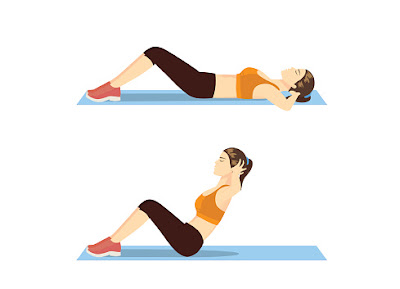The abdominal muscles are the most difficult for beginners to develop because they take a long time to develop and need a low amount of bo...
The abdominal muscles are the most difficult for beginners to develop because they take a long time to develop and need a low amount of body fat to be visible.
The abdominal muscle group is made up of three major muscles:
1. Rectus
abdominis – also referred to as the abs, is a long flat muscle wall that
extends from the lower chest to the pubic bone. The linea alba is a midline band of
connective tissue that separates two parallel muscles. It runs from the pubic
symphysis, pubic crest, and pubic tubercle inferiorly to the xiphoid process
and costal cartilages of ribs V to VII superiorly. The pubic crest and pubic
symphysis are the proximal attachments. It attaches distally to the costal
cartilages of ribs 5-7 and the sternum's xiphoid process.
The rectus
sheath, which is made up of the aponeuroses of the lateral abdominal muscles,
contains the rectus abdominis muscle. The linea semilunaris is the rectus's
outer, most lateral line. The rectus abdominis is divided into distinct
muscle bellies by bands of connective tissue that run through it. These muscle
bellies can be seen externally in the abdomens of people with low body fat.
They will appear in groups ranging from two to twelve. However, six is the most
popular.
2. Obliquus
abdominis – also known as the obliques, this muscle extends diagonally from the
lower ribcage to the pubic region. Internal obliques are located under the
external obliques.
The
external oblique muscle is located on the lateral and anterior sides of the
abdomen. It is long, small, and irregularly quadrilateral, with the muscular
portion on the side and the aponeurosis on the anterior wall of the abdomen.
Because of subcutaneous fat deposits and the small size of the muscle, the
oblique is not visible in most humans (especially females).
It is
formed by eight fleshy digitations, one on each of the external surfaces and
inferior borders of the fifth to twelfth ribs (lower eight ribs). These
digitations are arranged in an oblique line that runs inferiorly and
anteriorly, with the upper digitations attached near to the cartilages of the corresponding
ribs, the lower digitations attached to the apex of the cartilage of the last
rib, and the intermediate ones attached to the ribs at a distance from their
cartilages.
3.
Transversus abdominis – a thin line of muscle running horizontally around the
abdomen. The transverse abdominal, so named because of the orientation of its
fibers, is the innermost of the flat abdominal muscles. It is located directly
within the internal oblique muscle.
The
transverse abdominal fibers arise as fleshy fibers, the anterior tri-vierths of
the inner lip of the iliac chest, the inner surfaces of the lower six ribs,
interdigitation with the diaphragm and the thoracic Columbus. The transverse
abdominal fibers are made up of fleshy fibers. The latter ends in a broad
aponeurosis, with the lower fiber curved anteromedially (mediately and
downward) inserted in the crest of the pubis and pectineal side, along with
that of the internal oblique muscle; the inguinal joint tendon is often
referred to as aponeurotic fax.
You can
effectively target these muscles by performing the exercises mentioned below.
1. Crunches
– three sets of 15-20 repetitions. This exercise targets the upper abs.
2. Pelvic
tilts – three sets of 15-20 repetitions. This exercise will target the lower
abdomen, just below the navel.
3. Side
bends – three sets of 15-20 repetitions. This exercise will strengthen the
obliques.
As with all
workouts, you must exercise caution when scheduling particular body parts. To
begin, integrate abdominal exercises into a programme similar to the one
outlined below:
Day One:
Biceps, Back, and Abs
Day 2
focuses on the hamstrings, shoulders, and abs.
Day 3:
Quadriceps, Forearms, and Calves
Triceps,
Chest, and Abs on Day 4.
Complete
one set for the first couple of weeks, then add one set per week up to a
maximum of three. After three months, you'll be able to progress to more
rigorous intermediate-level workouts.









Thanks, I am really happy with these great tips! Gym management software option for managing your team and tracking essential operations in your fitness facility. Using Coast, you can easily stay in touch with employees, share and manage schedules, create to-do lists, and manage work orders when equipment malfunctions. Please visit our website for finding more information about gym management software.
ReplyDelete